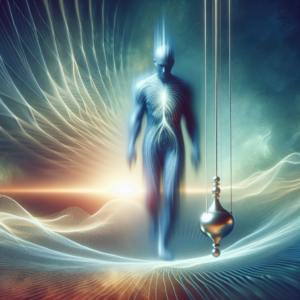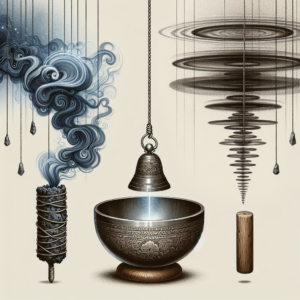
Key Takeaways
- Reiki is a form of energy healing that taps into universal life energy for wellness and balance.
- Pendulum dowsing is a tool used to read energy fields and gain insights into health and spiritual questions.
- Combining Reiki and pendulum dowsing can enhance healing practices and provide deeper understanding of energy imbalances.
- It is important to choose the right pendulum and to cleanse it properly before use to ensure clear readings.
- Practicing with intention and a clear mind is crucial for mastering advanced Reiki and pendulum dowsing techniques.
Embarking on a journey of energetic healing can be transformative, and when we harness the ancient practices of Reiki and pendulum dowsing, we unlock powerful tools for our wellness arsenal. Let’s explore how these techniques can synergize to create a profound healing experience.
Foundation of Reiki Healing Energies
Reiki is an art, a touch-based healing technique that channels universal life energy—the unseen force that animates all living things. As a Reiki practitioner, it’s essential to understand that this energy is not generated from within us but rather conducted through us. Think of yourself as a conduit, a kind of spiritual straw through which the energy sips into the recipient’s body, promoting healing, balance, and well-being.
At its core, Reiki is about balance. It’s about aligning the body’s energy centers, or chakras, and allowing energy to flow freely. When our energy is balanced, we feel grounded, centered, and ready to take on the world. But when it’s blocked, we can feel out of sorts, both physically and emotionally.
Pendulum Dowsing 101: Refined Guidance Techniques
On the other hand, pendulum dowsing is like having a conversation with the subconscious mind. Using a pendulum—a small weight suspended on a chain or string—we can ask questions and receive answers based on the pendulum’s movements. It’s a bit like tapping into an internal GPS system that guides us towards understanding our energetic state.
Reiki: Connecting with Universal Life Energy
Now, let’s get practical. Reiki is not just a theory; it’s a practice. To connect with this universal energy, start by creating a calm environment. You might light a candle, play soft music, or simply sit in silence. Place your hands gently on or above your body, or the body of the person you’re healing, and allow the energy to flow. It’s not about pressure or massage; it’s about the gentle laying on of hands.
Remember, the key to effective Reiki practice is intention. You must focus on the goal of healing and be open to the energy that is available to us all. With practice, you will feel the energy as warmth, tingling, or a subtle pulsation in your hands.
Deep Dive into Reiki Symbols and Their Meanings
As you progress in your Reiki journey, you’ll encounter symbols—sacred tools that amplify and direct the energy. Each symbol has a specific purpose, from increasing the power of the healing energy to promoting emotional and mental healing, or even sending healing across distance and time.
For instance, the Cho Ku Rei symbol is often referred to as the “power switch” because it increases the flow of energy. The Sei He Ki symbol addresses emotional and mental balance, and the Hon Sha Ze Sho Nen allows the practitioner to send healing energy across space and time, a practice known as distance healing.
Mastering the Hand Positions for Optimal Energy Flow
Mastering Reiki involves learning specific hand positions that correspond to the body’s energy centers. By placing your hands on or near these areas, you can channel energy where it’s needed most. Here’s a simple guide:
- Head: Crown, Third Eye, and Throat chakras
- Torso: Heart, Solar Plexus, Sacral, and Root chakras
- Limbs: Points along the arms and legs to address energy flow to extremities
It’s like a map of touch points that guide the healing journey. But don’t worry about being perfect; intention and presence are more important than precision.
Distance Healing: Bridging Physical Gaps with Reiki
One of the most advanced aspects of Reiki is the ability to heal from afar. Distance healing is based on the principle that energy is not confined by time or space. Therefore, by using the Hon Sha Ze Sho Nen symbol and focusing on the person in need, a Reiki practitioner can send healing energy across the globe as effectively as if they were in the same room.
Imagine your energy as a beacon of light, traveling across oceans and mountains, reaching the person in need and wrapping them in a warm, healing embrace. That’s the power of distance Reiki.
Distance healing can be a profound experience, both for the giver and the receiver. It reminds us of our deep connection to one another and the boundless nature of healing energy.
Advanced Dowsing: Beyond the Basics
Once you’re comfortable with the basics of pendulum dowsing, it’s time to elevate your practice. Advanced dowsing techniques involve a deeper understanding of energy fields and how to interact with them for healing and insight.
Energy Clearing and Shielding with Your Pendulum
Energy clearing is a crucial step in maintaining a harmonious environment for yourself and others. Your pendulum can serve as a powerful ally in this process. Begin by holding your pendulum over the area or person you wish to clear. Set a clear intention to remove any negative or stagnant energies. As the pendulum moves, visualize it collecting and dispelling these energies, leaving behind a clean, vibrant space.
Shielding, on the other hand, involves creating a protective energy barrier. After clearing, hold your pendulum still and envision an impenetrable shield of light around the space or person. This acts as a filter, keeping out unwanted energies while allowing healing ones to pass through.
Mapping Energetic Blockages and Balancing Chakras
With advanced dowsing, you can identify and map out areas of energetic blockage. Gently swing your pendulum over the body, starting from the crown and moving down to the root chakra. Pay attention to the pendulum’s behavior—sudden changes in movement can indicate an imbalance. Once identified, you can focus Reiki healing on these areas to restore energetic harmony.
Chakra balancing with a pendulum is a delicate art. Each chakra has its own frequency, and the pendulum can be used to tune into these energies. A balanced, circular motion indicates a healthy chakra, while erratic or stalled movement suggests an area that needs attention.
Conducting a Dowsing Session for Others
When conducting a dowsing session for someone else, it’s important to create a serene environment and to have the person relax as much as possible. Clear communication about what they can expect and obtaining their consent is essential. As you work, narrate your findings and ensure they feel comfortable and involved in the process. This not only enhances the session’s effectiveness but also empowers them in their own healing journey.
Reiki and Pendulum Dowsing Fusion
When Reiki and pendulum dowsing are combined, they create a dynamic healing duo. This fusion allows for a more nuanced approach to energy work, providing both general healing and targeted insights.
Synergizing Techniques for Amplified Healing
Integrating Reiki and pendulum dowsing starts with setting an intention that aligns with both modalities. During a Reiki session, you may use the pendulum to guide where to focus the healing energy. As you channel Reiki, periodically check in with the pendulum to assess the energy flow and make any necessary adjustments.
Crafting Intuitive Healing Sessions with Dual-Modality Approach
Each healing session is unique, and when you combine Reiki with pendulum dowsing, you allow your intuition to guide the process. For instance, you might be drawn to spend more time on a specific chakra or to use a particular Reiki symbol based on the pendulum’s feedback. This tailored approach ensures that the healing is personalized and deeply effective.
For example, if your pendulum indicates a blockage at the heart chakra, you might focus your Reiki practice on that area, using the Sei He Ki symbol to aid in emotional release.
Integrative Practices for Personal and Client-Based Work
Whether you’re working on yourself or with clients, the integration of Reiki and pendulum dowsing should be seamless. Start each session with a clear mind and a grounded presence. Trust in the tools and your connection to the universal energy to guide your hands and the pendulum. Documenting your sessions can provide valuable insights and help track progress over time.
Towards Mastery: Cultivating Intuition and Trust
Trust in your abilities and the process is the cornerstone of mastery in energetic healing. It’s not just about technique; it’s about believing in the unseen and knowing that the energy you channel has a purpose and direction.
As you practice, you’ll notice subtle shifts—both in yourself and those you heal. These changes are signs of deepening intuition and a growing bond with the universal energy you work with. Embrace them as markers on your path to mastery.
Developing sensitivity to subtle energetic changes comes with time and practice. You might find that your hands tingle in certain areas or that your pendulum swings more vigorously. These are your cues, the language of energy speaking to you. Listen closely, and let this dialogue expand your understanding and enhance your healing practice.
Most importantly, remember that Reiki and pendulum dowsing are skills of the heart as much as they are of the hands. Approach each session with compassion and a sincere wish for healing, and you’ll find that the energy flows more freely, the pendulum swings more truly, and the healing you facilitate reaches deeper than you ever imagined.
Developing Sensitivity to Subtle Energetic Changes
As you delve deeper into the practices of Reiki and pendulum dowsing, you’ll start to notice subtle energetic shifts. These can manifest as a warm sensation in your palms during Reiki or an unexpected sway of the pendulum when dowsing. To enhance this sensitivity, pay attention to the nuances of energy. It’s like tuning into a radio frequency—fine-tune your awareness, and the messages will become clearer.
Enhancing Your Healing Abilities with Meditation and Practice
Meditation is a powerful tool for amplifying your healing abilities. It quiets the mind, sharpens focus, and allows you to connect with your inner wisdom. By incorporating meditation into your daily routine, you create a fertile ground for your intuition to grow. Coupled with regular practice of Reiki and pendulum dowsing, meditation helps to solidify your connection to the universal life energy and the subtle vibrations of the pendulum.
Frequently Asked Questions
As we embrace the journey of energetic healing, questions naturally arise. Here are some of the most common inquiries about Reiki and pendulum dowsing, answered to shed light on these profound practices.
How Can Reiki and Pendulum Dowsing Complement Each Other?
Reiki and pendulum dowsing complement each other by providing a holistic approach to energy healing. Reiki channels universal life energy to promote balance and wellness, while pendulum dowsing offers a method for gaining insights into the energy field. Together, they allow a healer to both read and influence the energetic body, leading to a more complete healing experience.
For instance, you might use a pendulum to identify a blockage in the chakras and then apply Reiki to that specific area to encourage energy flow. Alternatively, after a Reiki session, the pendulum can be used to confirm that the energy has been balanced effectively.
Ultimately, the combination of Reiki and pendulum dowsing provides a more nuanced understanding of the energetic state and enhances the healer’s ability to address specific issues.
Is It Necessary to Be Certified to Practice These Techniques?
While certification is not a legal requirement to practice Reiki or pendulum dowsing, it is highly recommended to receive proper training. Certification ensures that you have been taught by experienced practitioners and understand the ethical considerations and techniques involved in energy healing. It also instills confidence in your clients that you have a commitment to professionalism and ongoing learning.
What Are the Signs of Progress in Reiki and Pendulum Work?
Progress in Reiki and pendulum dowsing is often marked by increased intuition, confidence, and the ability to perceive subtle energy shifts. Here are some indicators:
- Feeling more in tune with the needs of the person you’re healing.
- Receiving clearer and more consistent responses from your pendulum.
- Observing tangible improvements in the wellbeing of those you work with.
Remember, progress can be gradual, and it’s important to honor your journey without comparing it to others.
How Often Should Reiki and Dowsing Techniques Be Practiced?
Consistent practice is key to mastering Reiki and pendulum dowsing. Aim to engage in Reiki self-healing daily, even if only for a few minutes. Pendulum dowsing can be practiced several times a week to maintain and enhance your proficiency. As with any skill, the more you practice, the more attuned you will become to the subtle energies you’re working with.
However, it’s also important to listen to your body and intuition. If you feel drained or overwhelmed, it may be a sign to rest and recharge before continuing your practice.
Can Pendulum Dowsing Be Used for Decision-Making?
Pendulum dowsing can be a supportive tool for decision-making by helping you tap into your subconscious mind. It’s not about the pendulum making decisions for you; rather, it reflects your inner knowledge and can bring clarity to a situation. When using a pendulum for this purpose, it’s crucial to ask clear, unbiased questions and remain open to the answers you receive.
However, it’s essential to use discernment and not rely solely on pendulum dowsing for significant life choices. It should be used as one of many tools in your decision-making process, complemented by practical considerations and other forms of guidance.



